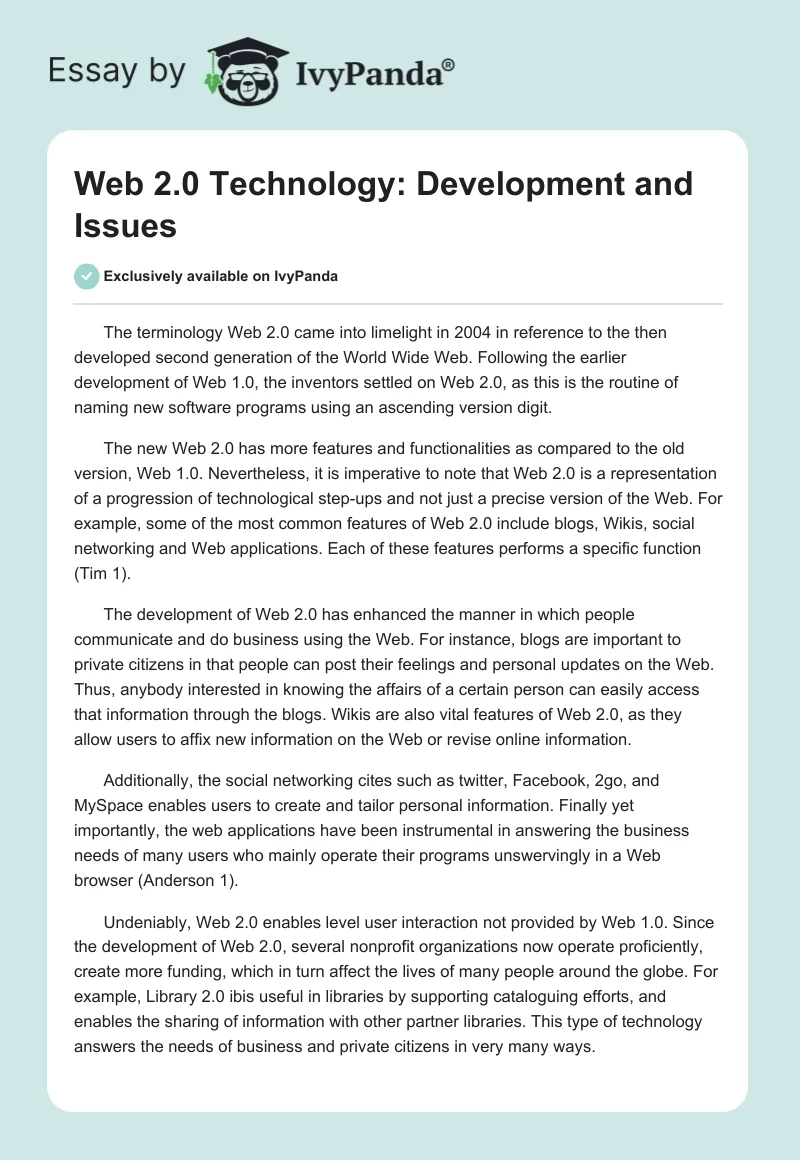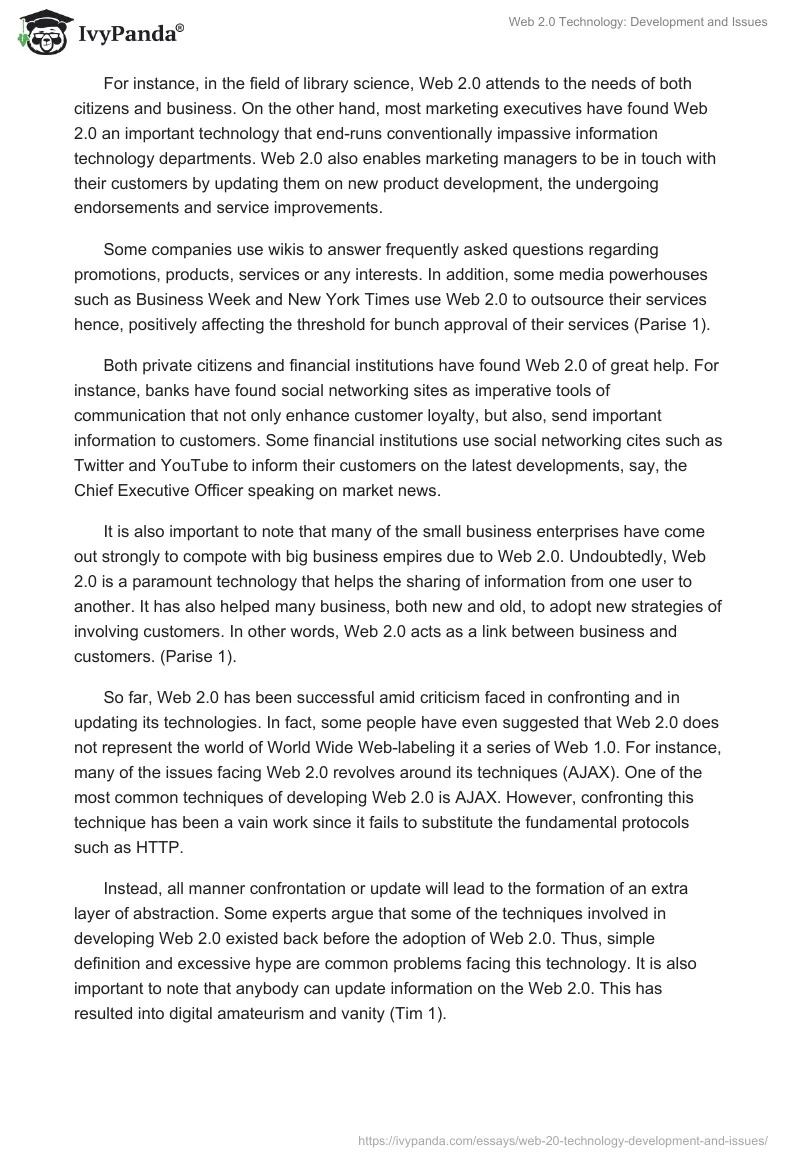The terminology Web 2.0 came into limelight in 2004 in reference to the then developed second generation of the World Wide Web. Following the earlier development of Web 1.0, the inventors settled on Web 2.0, as this is the routine of naming new software programs using an ascending version digit.
The new Web 2.0 has more features and functionalities as compared to the old version, Web 1.0. Nevertheless, it is imperative to note that Web 2.0 is a representation of a progression of technological step-ups and not just a precise version of the Web. For example, some of the most common features of Web 2.0 include blogs, Wikis, social networking and Web applications. Each of these features performs a specific function (Tim 1).
The development of Web 2.0 has enhanced the manner in which people communicate and do business using the Web. For instance, blogs are important to private citizens in that people can post their feelings and personal updates on the Web. Thus, anybody interested in knowing the affairs of a certain person can easily access that information through the blogs. Wikis are also vital features of Web 2.0, as they allow users to affix new information on the Web or revise online information.
Additionally, the social networking cites such as twitter, Facebook, 2go, and MySpace enables users to create and tailor personal information. Finally yet importantly, the web applications have been instrumental in answering the business needs of many users who mainly operate their programs unswervingly in a Web browser (Anderson 1).
Undeniably, Web 2.0 enables level user interaction not provided by Web 1.0. Since the development of Web 2.0, several nonprofit organizations now operate proficiently, create more funding, which in turn affect the lives of many people around the globe. For example, Library 2.0 ibis useful in libraries by supporting cataloguing efforts, and enables the sharing of information with other partner libraries. This type of technology answers the needs of business and private citizens in very many ways.
For instance, in the field of library science, Web 2.0 attends to the needs of both citizens and business. On the other hand, most marketing executives have found Web 2.0 an important technology that end-runs conventionally impassive information technology departments. Web 2.0 also enables marketing managers to be in touch with their customers by updating them on new product development, the undergoing endorsements and service improvements.
Some companies use wikis to answer frequently asked questions regarding promotions, products, services or any interests. In addition, some media powerhouses such as Business Week and New York Times use Web 2.0 to outsource their services hence, positively affecting the threshold for bunch approval of their services (Parise 1).
Both private citizens and financial institutions have found Web 2.0 of great help. For instance, banks have found social networking sites as imperative tools of communication that not only enhance customer loyalty, but also, send important information to customers. Some financial institutions use social networking cites such as Twitter and YouTube to inform their customers on the latest developments, say, the Chief Executive Officer speaking on market news.
It is also important to note that many of the small business enterprises have come out strongly to compote with big business empires due to Web 2.0. Undoubtedly, Web 2.0 is a paramount technology that helps the sharing of information from one user to another. It has also helped many business, both new and old, to adopt new strategies of involving customers. In other words, Web 2.0 acts as a link between business and customers. (Parise 1).
So far, Web 2.0 has been successful amid criticism faced in confronting and in updating its technologies. In fact, some people have even suggested that Web 2.0 does not represent the world of World Wide Web-labeling it a series of Web 1.0. For instance, many of the issues facing Web 2.0 revolves around its techniques (AJAX). One of the most common techniques of developing Web 2.0 is AJAX. However, confronting this technique has been a vain work since it fails to substitute the fundamental protocols such as HTTP.
Instead, all manner confrontation or update will lead to the formation of an extra layer of abstraction. Some experts argue that some of the techniques involved in developing Web 2.0 existed back before the adoption of Web 2.0. Thus, simple definition and excessive hype are common problems facing this technology. It is also important to note that anybody can update information on the Web 2.0. This has resulted into digital amateurism and vanity (Tim 1).
Take for example wikis. Many people update false information on wikis and mislead other people who are genuinely searching for information. Thus, the issue of security is a great concern to many users of Web 2.0. The vulnerability of Web 2.0 attack lies in the fact that any individual can upload the stored contents. Thus, hackers find it easier to carry out their malicious intentions. Of course, this will affect both business and private citizens who rely on such websites for information regarding certain affairs or even market news.
Software developers agree that Web 2.0 is prone to attacks due technical loopholes. Otherwise, the only sure way of protecting Web 2.0 from hacking and message retrieval is using a multifaceted JavaScript code on the user machines. However, even with the multifaceted JavaScript, the URL filtering and cataloguing products do not incriminate nor block some popular sites such as Wikipedia and MySpace, and considers them trusted even when they pose danger.
The biggest question however is how companies should address the issue of insecurity as posed by Web 2.0. In dealing with the problem, software researchers have embarked in the development of assistive technologies that will provide security to this technology. For instance, companies have developed new security solutions with the potential of examining and analyzing every web request or reply before taking an action. A very good example of such security solution is the real-time code analysis.
Since the technology is prone to very many attacks, the real-time code analyzer inspects the exchanges between the browser and the web servers. Here, every bit of information must undergo scrutiny to identity its authenticity, irrespective of its source.
By doing this, the technology ensures that malevolent information whether from trusted sites or otherwise, does not penetrate into the network. Thus, all networking sites and web pages like Facebook, MySpace, Gamma, Twitter and Yahoo pass through the analyzer just like any other normal web page (Yuval 1).
Like any other web technology, Web 2.0 and is prone to ever-emerging complicated web-borne threats. The exploitation of AJAX has reached a compromising state hence, the need for commanding security solutions, which will protect them from malicious intentions. Companies should therefore espouse profound approaches, which involve synchronized (real-time) inspection and signature-based security technologies.
In addition, some companies are busy deploying manifold security solutions aimed at protecting the company’s confidential information and internet-based resources. It is also important for companies to mount a security machine right at the internet gateway to carry out real-time code inspection of information that enters and leaves the commercial network. Such actions will address the issue of insecurity that is so common in Web 2.0 technologies (et.al. 1).
Works Cited
Anderson, Paul. What is Web 2.0? Ideas, technologies and implications for education. JISC Technology and Standards Watch. 2007. Web.
Parise, Salvatore. The Secrets of Marketing in a Web 2.0 World. The Wall Street Journal. 2008. Web.
Tim, O’Reilly. What Is Web 2.0? O’Reilly Network. 2005. Web.
Tim, O’Reilly. Amazon Web Services API. O’Reilly Network. 2002. Web.
Yuval, Ben-Itzhak. Tackling the security issues of Web 2.0. 2007. Web.


